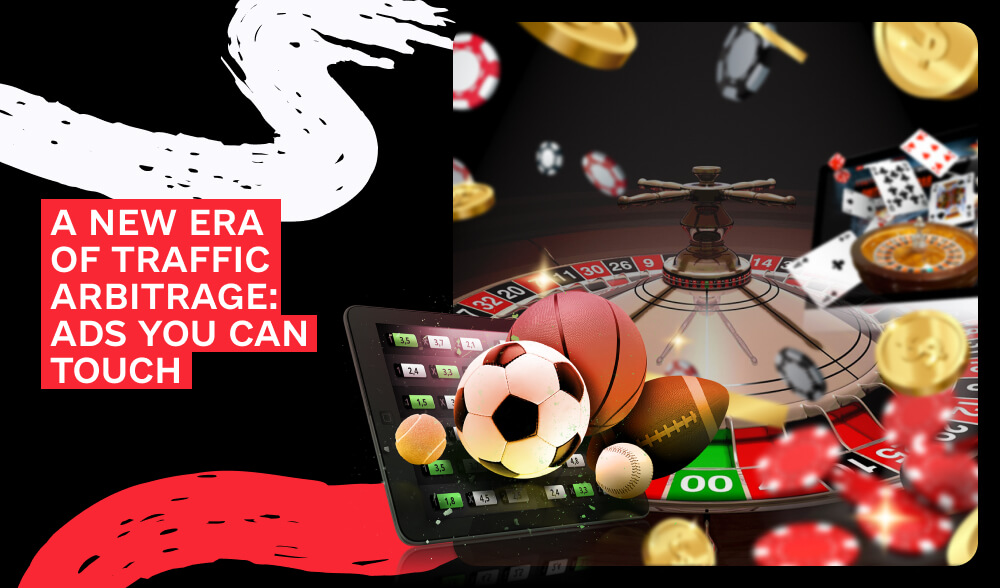Don't miss interesting news

Even the coolest ads and catchy copy can get boring. It used to be enough to make a bright picture in Photoshop and ensure a high CTR, but now users just scroll on. What can we do? At the very least, we should use video creatives, and at the most, we should use VR and AR to give people the opportunity to interact with the product.
Let’s see how these two approaches differ, how big brands use them in advertising, and how arbitrageurs can use these technologies in their campaigns.
AR (augmented reality) is like a portal to the virtual world, but in reverse. It doesn’t transport us to another reality, but integrates digital elements into our daily lives. Remember the popular game Pokemon GO, where you had to catch Pokemon in real locations – this is an example of AR.
This technology allows you to “try on” things online: furniture in your room, a new dress, or even change your hair color. All you need to do is turn on the camera or upload a photo and overlay virtual objects on it.
When a user can at least virtually test a product before buying, trust in the brand and the product itself increases. This directly affects the conversion rate. This is especially popular in cosmetics, accessories, hair dyes, or stylist services. For example, the L’Oreal Paris brand has created a virtual assistant that helps to evaluate how a new makeup will look like.
Using such a service is easy: clear instructions, user-friendly interface, and the ability to immediately add the product to the cart.
In the gut niche, you can show how the serum works against wrinkles or acne. You can do this right on the preview with filters that simulate smooth skin or other effects. Or you can demonstrate the results of slimming pills: show how the body will look like after losing 5, 10, or 15 kg, and the customer will definitely want to buy the product here and now.
AR and VR open up new opportunities in arbitrage, and you should definitely not ignore them!
Large furniture and appliances brands have been using AR for a long time to allow customers to imagine how the purchase will look in their interior. For example, IKEA has created an app that allows you to project furniture into a room using a smartphone camera to better understand the actual dimensions.
What about arbitration? Thanks to this technology, you can show the real dimensions of household goods, including popular appliances, interior items, or products from China. Using augmented reality, users can look at products from all sides in a 3D model to notice all the details. This technology will also be useful in the travel vertical, helping to showcase hotels, localities, or main attractions before booking.
VR technologies offer a full-fledged three-dimensional environment that creates a sense of almost real presence. Immersion requires special VR glasses that are not cheap, so this approach is best suited for advertising in the gaming industry and related niches, where the target audience usually already has a VR headset. Examples of advertising using VR are still rare, but this topic has great potential, given the growing demand for the equipment worldwide.
Virtual reality is now being actively used to create immersive 360° product demonstrations. This approach is ideal for premium products or complex products where atmosphere is important. For example, Pepsi launched the Pepsi Go Back project, where users could travel back in time.
Will VR be useful for ordinary arbitrageurs? This is an open question. On the one hand, the technology looks very cool, and there are certain niches where it can be applied. But on the other hand, such advertising will be appreciated only by those who have VR devices. Experts predict that by 2025, the number of AR/VR gadget users in the world will grow to 216 million.
One of the areas of VR application in arbitration is adult creatives. For example, advertising gels, creams, or pills with a visual effect, as well as promoting dating apps.
VR is also great for fitness and iGaming. Virtual games allow you to immerse yourself in the process as much as possible: you can “enter” a virtual gym, perform simple exercises, focusing on hints or interacting with virtual objects.
And, of course, the first thing that comes to mind when it comes to VR in traffic arbitrage is casinos and betting. Imagine how cool it would be to “attend” a match, feel the intensity of fans’ emotions, or even see your opponents at the poker table. With VR, all this becomes as real as possible.
Despite all the advantages, the use of virtual and augmented reality has not yet become a mass phenomenon. There are two main obstacles that complicate their implementation:
With the development of VR and AR, their integration into affiliate marketing and traffic arbitrage will be only a matter of time. Such technologies create a real “wow” effect, which significantly increases conversions and helps to promote products. At the same time, not all advertisers have access to them yet, and suitable offers will have to be found in affiliate programs. AR technologies can already be adapted to different verticals, while VR advertising works better for campaigns targeting gamers, casinos, or adventurous audiences.